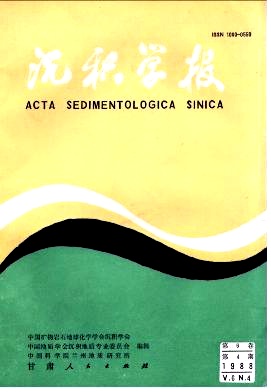A STUDY ON THE ENVIRONMENT OF UPPER ORDOVICIAN FLYSCH IN WESTERN ZHEJIANG AND SOUTHERN ANHUI PROVINCES AND A SHORT COMMENT ON THE APPLICATION OF BOUMA' S SEQUENCE
- Received Date: 1986-07-04
- Publish Date: 1988-12-10
Abstract: The Upper Ordovician flysch deposits with 1200m in thickness occurs in Western Zhejiang Province. The formation was first described by Guan Yinwen etc. in 1959, and it was considered to be shallow marine deposits. Later some reserchers regarded it as a turbidite of deep sea. The authors suggest that this formation is not a turbidite formed in deep sea but a flysch deposited in the area extending from shallow sea to tidal flat. The following characters may be listed; 1.Graded bedding shows diverse types, i.e. graded sand (Aa),graded silt(Ab),and reversal graded silt(Ac). Aa, Ab, and Ac can occur within one of the flysch rhyt-thmic beds. Ab and Ac may be combined to a bidirectional graded bedding Ab-Ac or Ac-Ab. 2.There are a large number of ripple marks, such as current ripple marks,sym-trical and asymmetrical wave built ripple marks and interference ripple marks. The asymmetrical ripple marks and foreset laminations are of bidirectional proprety. 3.There are also sandstones with wave bedding and lenticular bedding. 4.The main direction of sole marks is parallel to the shore line, and there are also bidirectional. 5.Mudstones of the uppermost part of a rhythmic bed contain pelitic or silt gravels,and they often show foreset and lenticular laminations. 6.There are three different grades of rhythmic bed, i.e. gross-rhythmic, fine-rhythmic and micro-rhythmic bedsOne gross-rhythmic bed may contain several fine rhythmic beds,and one fine-rhythmic bed may contain several micro-rhythmic beds which can only be observed by means of microscope. Graded textures, foreset laminations, lenticular beddings, flaser beddings, scour marks, and bioturbations can be found in the micro-rhythmic beds. he facts mentioned above show that the flysch rhythmic beds in the area do ot result from a single kind of process ( such as turbidity currents) in deep sea but from the combination of several processes, such as sea waves, bottom currents, tidal flows, storm surge currents and climatic effects, etc. The most favorable environment in which such diverse kinds of hydrodynamic factors take effect is the area extending from shallow sea to tidal flat. Of course, the sequences of the flysch rhythmic beds, to some extent, are similar to Bouma's Sequence-a sedimentary model about turbidites. It is not very diffic-ult to find out the intervals like A,B,C,D,and E of Bouma's Sequence in the flysch rhythmic beds. According to these characters some reserchers treated the flysch as a deep sea turbidite. It must be pointed out that there are a lot of significant phenomena being ignored by the above-mentioned reserchers. So, we must take a careful and analytic approach in the applications of Bouma's Sequence,and we may not consider the Bouma's Sequence as a conventional and universal model.
| Citation: | Xia Bangdong, Lu Hongbo. A STUDY ON THE ENVIRONMENT OF UPPER ORDOVICIAN FLYSCH IN WESTERN ZHEJIANG AND SOUTHERN ANHUI PROVINCES AND A SHORT COMMENT ON THE APPLICATION OF BOUMA' S SEQUENCE[J]. Acta Sedimentologica Sinica, 1988, 6(4): 44-51. |






 DownLoad:
DownLoad: